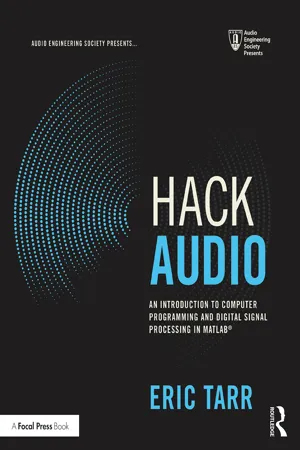
Hack Audio
An Introduction to Computer Programming and Digital Signal Processing in MATLAB
- 458 pages
- English
- ePUB (mobile friendly)
- Available on iOS & Android
About this book
Computers are at the center of almost everything related to audio. Whether for synthesis in music production, recording in the studio, or mixing in live sound, the computer plays an essential part. Audio effects plug-ins and virtual instruments are implemented as software computer code. Music apps are computer programs run on a mobile device. All these tools are created by programming a computer.
Hack Audio: An Introduction to Computer Programming and Digital Signal Processing in MATLAB provides an introduction for musicians and audio engineers interested in computer programming. It is intended for a range of readers including those with years of programming experience and those ready to write their first line of code. In the book, computer programming is used to create audio effects using digital signal processing. By the end of the book, readers implement the following effects: signal gain change, digital summing, tremolo, auto-pan, mid/side processing, stereo widening, distortion, echo, filtering, equalization, multi-band processing, vibrato, chorus, flanger, phaser, pitch shifter, auto-wah, convolution and algorithmic reverb, vocoder, transient designer, compressor, expander, and de-esser.
Throughout the book, several types of test signals are synthesized, including: sine wave, square wave, sawtooth wave, triangle wave, impulse train, white noise, and pink noise. Common visualizations for signals and audio effects are created including: waveform, characteristic curve, goniometer, impulse response, step response, frequency spectrum, and spectrogram. In total, over 200 examples are provided with completed code demonstrations.
Frequently asked questions
- Essential is ideal for learners and professionals who enjoy exploring a wide range of subjects. Access the Essential Library with 800,000+ trusted titles and best-sellers across business, personal growth, and the humanities. Includes unlimited reading time and Standard Read Aloud voice.
- Complete: Perfect for advanced learners and researchers needing full, unrestricted access. Unlock 1.4M+ books across hundreds of subjects, including academic and specialized titles. The Complete Plan also includes advanced features like Premium Read Aloud and Research Assistant.
Please note we cannot support devices running on iOS 13 and Android 7 or earlier. Learn more about using the app.
Information
Chapter 1
Introduction
1.1 Introduction: Computer Programming and Digital Signal Processing
1.2 The Purpose of This Book
1.3 Intended Readers
1.4 Topics Covered
1.5 Additional Content
Chapter 2
Basics of Programming in MATLAB®
2.1 Introduction: Computer Programming in MATLAB
2.2 Programming Languages
Table of contents
- Cover
- Half Title
- Series Page
- Title Page
- Copyright Page
- Dedication Page
- Table of Contents
- List of Tables
- List of Figures
- List of Examples
- Acknowledgements
- Chapter 1: Introduction
- Chapter 2: Basics of Programming in MATLAB
- Chapter 3: Basics of Audio in MATLAB
- Chapter 4: MATLAB® Programming Environment
- Chapter 5: Logicals and Control Structures in Programming
- Chapter 6: Signal Gain and DC Offset
- Chapter 7: Introduction to Signal Synthesis
- Chapter 8: Digital Summing, Signal Fades, and Amplitude Modulation
- Chapter 9: Stereo Panning and Mid/Side Processing
- Chapter 10: Distortion, Saturation, and Clipping
- Chapter 11: Echo Effects
- Chapter 12: Finite Impulse Response Filters
- Chapter 13: Infinite Impulse Response Filters
- Chapter 14: Delay Buffers and Fractional Delay Interpolation
- Chapter 15: Modulated Delay Effects
- Chapter 16: Algorithmic Reverb Effects
- Chapter 17: Amplitude Envelope Effects
- Chapter 18: Dynamic Range Processors
- Index